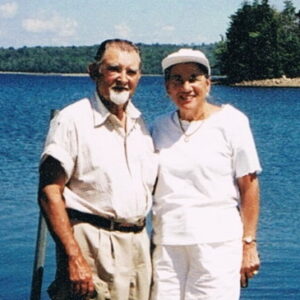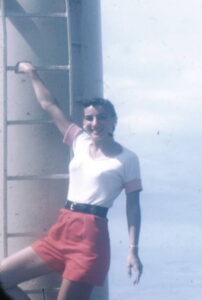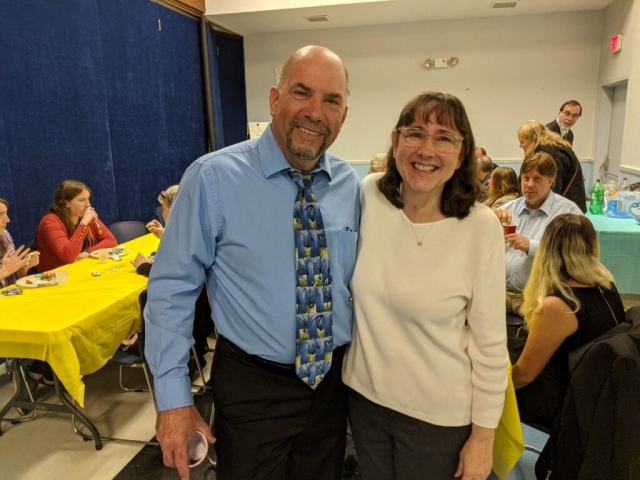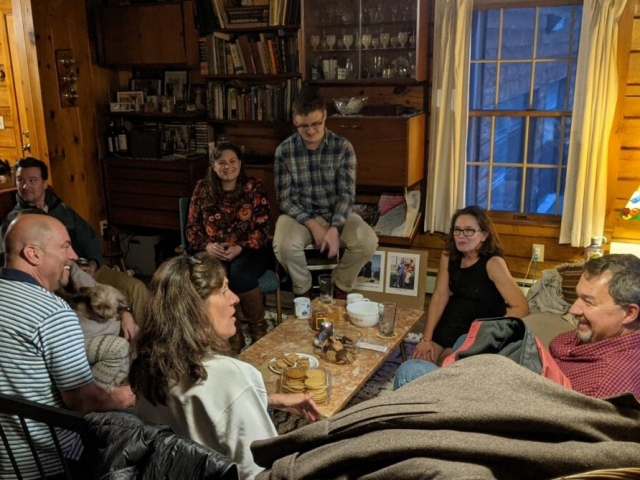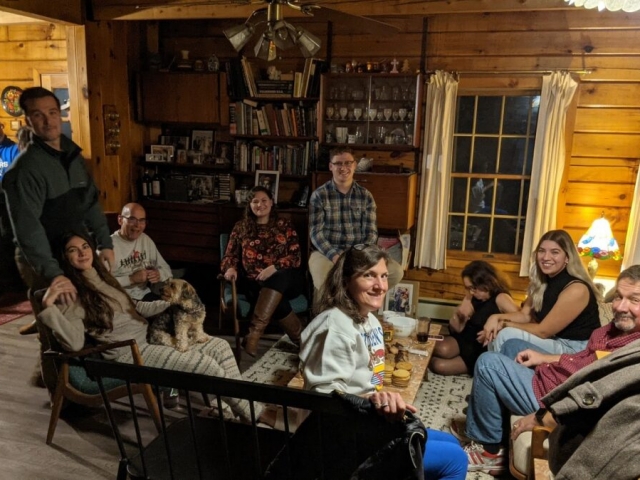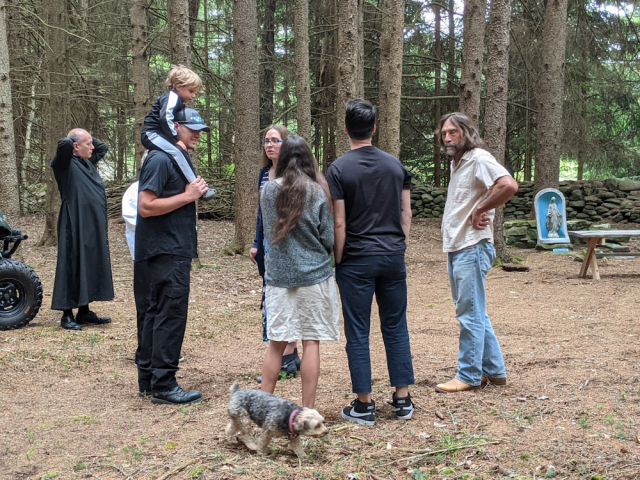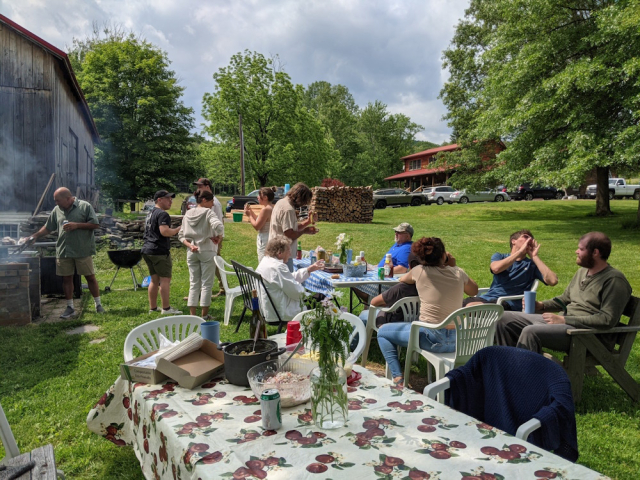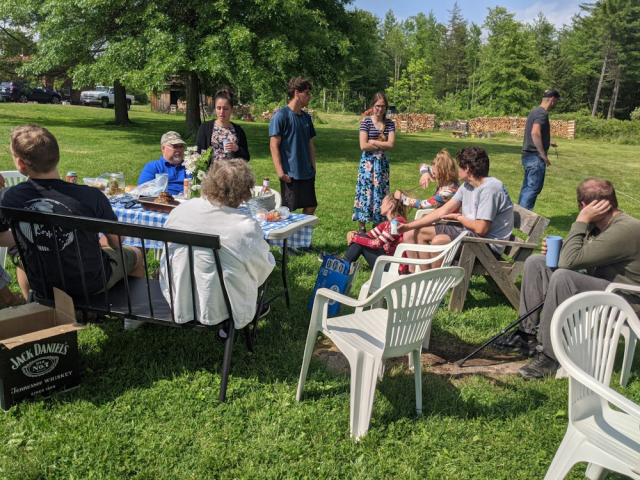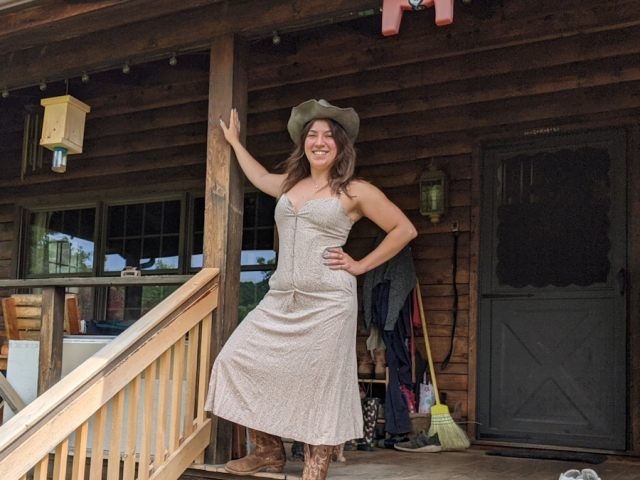Claire Therese May Christensen
Family Reunion in Heaven
Claire Therese Veronica May Christensen (12/26/30-9/20/21) completed her journey on earth and headed up to a big party in heaven where her husband and entire family had been waiting throughout the 7 years of her heroic battle with Alzheimer’s.
I can’t come up with enough adjectives to describe how great Mom was. Alzheimer’s was unable to take away the power of her love. A deeply prayerful Catholic, she worked tirelessly to bring up her children and taught us to be practical and adventurous.
We realize how lucky we are to have such wonderful role models for parents and happy that they were able to travel the world together before Dad passed away 15 years ago.
Claire’s Story: Childhood
Reminiscence of growing up in the 1930 – 40s in a religious, family oriented home in East New York, Brooklyn.
I entered the world on December 26, 1930, last of 9 children (5 boys, 4 girls) at Lutheran Hospital, Brooklyn, the only family member born in a hospital. My father, Joseph Otto May, “PAPA”, not “dad”, was 47 years old, active in the Church, a printer, with a great sense of humor. My mother, Rose (Hahn) May, “MAMA”, not “mom” was 45 years old, a diligent housewife, more reserved, suffering with severe diabetes. Of course, I was a “change of life” baby, near 10 lbs. At birth, and I was told that despite the precariousness of the expected near birth, Mama had marched right up to a front pew in St. Michael’s Church for midnight mass the previous Christmas morning.
I was baptized January 4, 1931 at St. Michael’s Church. The whole family joined in selecting a name for the new arrival, and “Dolores” was considered, until one of the parish priests noted that that was a sorrowful name, and “Claire” was chosen instead. Why not!! – St. Claire, a Franciscan saint in a Capuchin Franciscan parish.
I was the only child in the family not nursed, and was a rather sickly baby. The family doctor (Dr. May, but no relationship) tended me. Who ever even heard of a pediatrician in the ‘30s? But of course I must have been spoiled with attention. I became the baby doll that my older sisters had never owned.
In the hierarchy of the family, brother Joe at 22, and sisters Marie at 20, and Anna at 18, were presumably working or helping out at home, Bill at 16, Edward (later Fr. Eric) at 13, Andrew at 10, Charles at 8 and Helen at 5 ½ were at school. And so I received a goodly share of attention until I became a nuisance that affected their social lives and hence I was renamed “the Brat” (at least to my brothers). My older sisters continuously called me “Ootsie”. To Helen, who was often given the charge of watching me or dragging me along as she played outside, I was just a leach.
My May grandparents immigrated to America from Baden, Germany in 1877, and eventually settled in the East New York section of Brooklyn. There must have been a large contingency of Germans there, who aided in building the mostly German parish church of St. Michael, My mother and father met and married there Sept. 9, 1907. I did not know any of my grandparents, as all had died either before or shortly after my birth.
Somewhere along the line, after my mother’s mother was widowed and my parents were struggling with a growing family in an apartment, both my grandmother and my parents joined in buying the “2 family” house at 165 Miller Avenue, with the stipulation that when grandma died, we would continue to house and care for her only unmarried daughter, Tante Annie, as long as she lived. That is the environment I remember as I grew up.
Mama told me that when she first moved to 165, there was still a cow “up the street” but by now we were citified. My block consisted of mostly 2 story private houses, no two the same, with alleyways in between, several 3 story apartment buildings (“the flats” as we called them), a string of garages “up the block” used to house who knew what, and later, to serve as car garages for the few fortunate enough to own a car.
The BMT elevated train ran along Fulton Street, to the left of our house, which was in the middle of the block. The station was one block away on Van Siclen Avenue. Under the “EL” there were a string of small stores – the Candy store, where I eventually bought penny or 2 cent candies when I had the money, or ice cream cones for 5 cents when papa would deem it necessary, and the kosher deli type corner store that sold butter and cheese from huge crocks that was cut out as needed, pickles in a barrel and dry foods in huge sacks measured out by the pound. We had a shoe repair shop on the corner that had a rousing business, and across the street, a German deli. Many small stores came and went. There was a store around the corner near the EL train station that looked unoccupied and dismal. But on Sunday mornings, fresh bagels arrived by the bushel and customers lined up by following the fresh scent of garlic and onion.
Schmidt’s butcher shop was on the corner of Miller and Atlantic. There was sawdust on the floor and always a thick slice of bologna for any kid who came with a customer. Down the block on Atlantic was Fuchs dry goods store. There you could buy everything from thread and buttons to underwear and nightgowns. A 5 & 10 a few blocks away provided anything and everything “cheap” and a hardware store took care of nails to pots and pans. A small Bohack store around the corner on Atlantic Ave. appeared and that was the Cat’s meow. They sold grocery items such as canned goods, (one, perhaps two brands were available) and packages of cereal (corn flakes, shredded wheat and rice krispies) plus oatmeal (definitely not the instant kind), flour, salt, sugar, etc. Customers were served by a clerk – no self serve. Much later, a competitive A&P came one block away. It was self serve – everything you could fit into a very small basket from a short 3 aisle selection. A fish market, Italian butcher, pharmacy, baker and ice cream parlor were close.
The candy store on Atlantic and Miller was owned by the Antel family. They lived in two rooms behind the store with their two children while they saved enough to provide a good education for their children. One later became a doctor.
There were no supermarkets in the 30s. We purchased food from specific stores. The milkman brought milk and dairy products several times a week. You left a note for what was needed and the empty bottles for him, (no throw away bottles). There was only one kind of milk – pasteurized (4%). NOT homogenized. The cream rose to the top, and in the winter, sometimes it froze and the top cap popped off. You had to mix the cream into the milk each time you used it. Woe be the one who surreptitiously drank the cream off the top without mixing it in thoroughly. Wars were fought over less.
Fresh vegetables and fruits were brought by horse drawn wagon into the street at least once a week. Women would come out and choose the items they wanted to buy. They were weighed and paid for on the spot. I’m not sure if this went on in the winters as well. Every few weeks, or at least once a month, a van would come into the street and play a simple melody to invite people to come out with their dull knives and scissors to be sharpened. Bakeries such as Krugs or Drakes would come door to door with a basket of cakes, breads etc. to sell their products. My uncle Bill was known as the “coffee man”. He made his living selling coffee, teas, and various other foods (don’t forget the rice for weddings), originally by horse and wagon, and later from his truck. He carried a basket of his offerings into the homes of his customers and returned with the selected items. I think much of his success was his charming, friendly personality and terrific sense of humor that kept him loyal customers.
The first supermarket I remember was King Kullen in Woodhaven, and mama and papa would occasionally journey there to “stock up”. Of course, it was nothing like today’s supermarkets, but it WAS self service, and quite a novelty in its day. The first self service supermarket near Miller Ave. came in 1961 but did not last very long. It wasn’t very large, and as soon as more neighbors began to purchase cars, they preferred to drive to the rapidly growing larger stores.
My neighborhood changed a lot in the ‘30s. Our block on Miller Ave. was definitely diverse. On one side of our home were Italian, on the other, Jewish families. We had Irish, Greek, German, Polish, and who knows how many other nationalities represented. No one cared; there was never any friction. Some seemed to be better off financially, and there were others that were obviously very poor. No matter. The Van Siclen Ave. block behind us (our backyards faced each other) was another story. The “flats” behind us was home to an array of interesting people. Our view was of their fire escapes. There was lots of loud noise and fighting at times that often served as furtive entertainment in our TV-less home. In the dark, we children would sneak up to our back fence and try to follow the cast of characters who performed on the escapes, backlit by the lights in their kitchens.
Highland Park was about a 15minute walk from Miller Ave. In the upper park was a reservoir that served as a lure for a nice “walk around” or jogging trail. The lower park had the usual swings, monkey bars and see-saws, plus a nice sized concrete “wading pool” that held a few inches of water for kiddies, and /or water spouts that children could run in and out of on hot summer days. When WW2 began, a “victory” garden was started, and we children could be granted a small patch each (about 4’ x 8’) to plant vegetables. I don’t recall having much success, despite the obligatory tending of my plot, tho I may have been given an occasional veggie to take home, by a sympathetic counselor.
Arlington Ave. ran parallel to Fulton St., several blocks north. We children considered it the area of the “rich” people. The houses were larger and nicer and (we believed) that some people even had “help” – cleaning people, gardeners, etc. Once a year, there was a special parade on Arlington Ave. Mothers would adorn their children’s carriages, strollers, etc. with colorful decorations and march along the avenue. I believe it was sponsored by several Protestant churches in the neighborhood, and much enjoyed by large crowds.
The Long Island RR ran elevated over Atlantic Ave., parallel to Fulton St. It was always noisy and an eyesore. I don’t recall when, but it was finally dismantled and the LIRR was replaced by a subway. It took a very long time for the construction, during which rats invaded the neighborhood and all traffic was inconvenienced. At last it was finished making Atlantic Ave. look wide and bright. Eventually, Atlantic Ave. was awarded a bus, which I eventually took to HS in my final years there.
Another elevated train ran several blocks south and parallel to Atlantic, on Pitkin Ave. There was a station here also, and in my first few years of HS, I took the el towards Nassau County and my school. Ten or so years later, that el, too, was dismantled and the “A” subway train took its place. I later rode that IND train to my job in NYC.
South of Pitkin Ave. and past Pennsylvania Ave. was a very busy, primarily Jewish, shopping area of small stores and push carts. It was a very healthy walk from our house, but occasionally we enjoyed the hustle and bustle (and the bargains) and “schlepped” there.
What was life like in the 30’s for a large, religious family like the Mays? First of all, we were very family oriented, as were many people in those days before TV and the internet. Life basically revolved around the home, church and school. Extended family and friends were garnered mostly from the neighborhood/church societies. Entertainment for adults was mostly visiting back and forth, playing cards, musical instruments, games etc. Very young children (me) seemed to fall into the “to be seen, but not heard” mode. As I was “the baby” of our family I was kept particularly innocent of the world around us. This was not hard to do, with no TV or other electronic gadgets coming into our home, and every piece of printed material “censored” for my curiosity.
My fondest childhood memory of my father was his putting me on his lap on a Sunday morning and reading me the funnies. Katzenjama Kids was my favorite.
Papa was ahead of his times in many ways. He enjoyed tinkering with gadgets and kept up to date on all the new inventions, not too easy to do with a large family and very little money. We did have a black wall telephone (in the early 30s very few of our neighbors possessed home phones), and it was kept for important calls only. On the few occasions that I was caused to answer the ring, I was terrified that I wouldn’t be able to understand the message that I was given.
There was always company at our house. Every Sunday, it seemed, both dining room and “extension room” (our everyday dining room) were filled with family and friends.
A lot of pinochle was played there. My older brothers and sisters, in their 20’s, partied with their friends and cousins regularly. Joe played the piano, and several others played banjos. They called themselves the Banjomanians. Much fun and laughter. When I was a cute toddler, I was often the center of attention (or so they tell me). On one occasion, while I was still in my walker, I toddled around draining the dregs of the many wine glasses left by the partiers, and became looped. I guess I was the center of attention at THAT party.
We all attended Sunday mass. 9 AM was the children’s mass. Nighttime processions were frequent, for major feasts (such as May, Mary’s month, Easter and Corpus Christi). We children dressed up in our First Communion outfits, the toddlers in white dresses with wreaths of flowers, the boys in suits and white ties and paraded around the church while the congregation joined in singing hymns, followed by benediction. The church was always crowded on Sundays – all the neighborhood houses of worship were. For some special feasts, particularly Midnight mass at Christmas, you had to arrive very early to get a good seat.
There were many societies in the parish that served spiritual, material and social needs. The men had the Holy Name Society, St. Vincent de Paul, and K of C. For ladies, it was the Sodality of the Blessed Virgin Mary (single ladies), and Christian Mothers for the married ladies, and all kinds of sub-groups within these societies.
Social life was active. Every year there was a bazaar held in the church basement. There were numerous card parties sponsored by the various groups where card games and bunco were played. There were dances and plays, communion breakfasts and meetings of every sort. The entire parish during this period was a very close knit group, and most of the marriages evolved from this group. By the late 40’s and early 50’s, the neighborhood had changed considerably. Most of the old time families had drifted away and the parish was much less cohesive. The church dances were attended more and more by outsiders and trouble started drifting in until they were abandoned altogether. The whole area had suffered a tremendous upheaval, as did every other area.
There were many daily newspapers in the 30’s. They were either delivered by newsboys on bikes, or available at the candy store. In the morning, the News and Mirror (2 cents each) and in the afternoon, the Post, Journal American and Sun. I don’t recall what the L.I. Press cost; we had it delivered promptly every day, by Frank Deesing, Charlie’s friend. He visited all his customers every Friday for payment. An excellent tip would be 15 cents. In the early 30’s, we had 2 mail deliveries a day, always on time, (one on Saturday). There were penny post cards, and I think first class mail cost about 3 cents. A bus or trolley ride was 5 cents. It went up to 10 cents in the 40’s, an astronomical raise. At one time, I was given an allowance of 5 cents a week, raised to 50 cents in HS. For special occasions, such as First Communion, a gift of $2 was very nice, and $5 was very generous. In fact, even in 1955, at the time of my wedding, an average gift was $10 to $15. My average food shopping bill after marriage was about $18 to $25 a week.
My first job in 1948 paid $30 per week. In about ’51, when I went into advertising, I earned $50 per week, a very nice salary for a statistical typist. Of course, I brown bagged all thru school and work, just buying coffee etc., so there was lots to save.
I became a girl scout in the early 40’s and later a senior scout for about 5 years in all. We had the world’s worst scout leaders, but managed to salvage something from our experience nevertheless. I was a group leader, and my group met regularly at one another’s homes to work on badges, of which we amassed an amazing number, due to our ingenuity in parceling out assignments; for example, I did the artwork for everyone, because I was best at it….) each one did a part of the whole and then we pooled our resources. Our scout mistress never suspected, and was amazed at our prowess with earning badges.
There weren’t very many kids living on our block. But at playtime, they seemed to appear from everywhere. As a toddler, I made mud pies in my back yard with my friends Florence and Dolores Boll, who lived on the corner. Growing up, we all jumped rope (French, German, double Dutch, etc.), played hopscotch and all kinds of bouncing ball games – Russia, one, two, three a-nation etc. Street games were very popular, with girls AND boys, when you could muster up the necessary participants. Ring-a-lev-I-o, punch ball, 3 steps to Germany, Red Light/Green Light, Simon Says, etc. I roller skated in the street a lot (very few cars passed by, even fewer parked at the curbs.) I rarely left THE BLOCK. My circle of friends was limited to THE BLOCK, and occasionally, someone from AROUND THE CORNER.
Summer nights were very lively on Miller Ave. Mostly everyone would sit out on their porches or stoops after dinner to keep cool and watch the world go by till long after dark. There would be visiting and “keeping up on the local gossip” while we kids would play Hide’n’seek till called in by our parents. Sometimes, papa would give me 5 cents for an ice cream cone, which could be bought at the corner candy store. Occasionally, I was given money for the 1 or 2 cent candy that could be purchased there as well, and a long time was spent on deciding which candy to buy. My house had a very nice porch, shielded in front by the most beautiful wisteria vine. So we could observe the goings on undetected. We always watched for a neighbor to make his nightly jaunt to the bar on the corner with his little metal bucket for some tap beer. Papa called it “rushing the growler” tho I have no idea what that meant.
I loved playing with paper dolls and had a large collection, mostly purchased by Anna or Marie to spoil me. A large paper doll book would cost around 25 cents. Later, I played “Imagination” games with my “Little Men”, which were old chess pieces which I would “dress up” in fancy paper and cellophane costumes with paper that papa had brought home from work, and invent stories that the little people could act out.
St. Michael’s School was First to eighth grades (no kindergarten) Mon.- Fri.,) 9 – 3, with a 15 minute recess in the morning. Lunch was 12 – 1, and everyone walked home for lunch. My trip was 6 blocks each way. The school was staffed by Dominican nuns, who were good educators. Most of us learned to read and write (cursive first, from Day 1,) from Sr. Helen Thomas, who taught 1st grade forever, absorbed grammar from St. Christiana in 5th grade, and I had an 8th grade sister who, besides being an excellent teacher, could do more with her one arm than most others with 2. There were about 30 – 40 students in each class, and I don’t recall any particular disciplinary problems in grade school. An occasional rap on the knuckles with a ruler solved the occasional misstep. I do remember that in 4th grade, one of the boys caused poor sister some grief, and as she reached around for something to tap him with, she spied my prize ruler, given to papa by one of his business associates, and that held chips of all different woods. She grabbed the ruler and rapped him so hard that several of the chips popped out of the ruler. Case closed!
We were taught using the blackboard and chalk method. The erasers were always being used and dusting them out became a contest among the boys, as to who was given the honor. Many an eraser war broke out with all being reprimanded for coming in with chalk dust all over them. In the lower grades, flash cards were king, especially in arithmetic (not math). Each day began with a prayer AND reciting the Pledge of Allegiance.
There weren’t any parent/teacher conferences that I can recall. If a parent was called to the office, it would have had to be an occasion of catastrophic importance. School problems were solved at the school and backed up at home. After my first few days in Grade 1, I don’t think mama came back to the school except for the occasional playlet or special occasion.
We were expected to attend 8AM mass every school day, or at least on Fridays. After about the 5th grade, I belonged to the children’s choir that sang at this mass. The mass was then celebrated in Latin. Novena to our Blessed Mother was after school on Mondays.
At home after school, we faithfully tuned in to the Lone Ranger and Jack Armstrong, the all American Boy for their 15 minute segment radio shows. Nights and weekends we listened to I Love a Mystery (my favorite), the Great Gildersleeve, Fibber McGee and Molly, Jack Benny, the Green Hornet, Amos ‘n Andy, etc. Of course, this was after papa’s mandatory news shows – Lowell Thomas etal.
Sometimes, I did homework while I listened, but more usually, I drew pictures. I loved drawing. We played games, also – Mensch arger dich nich (loosely translated “Don’t Get Angry), Monopoly, Parcheesi, card games like rummy, Old Maid and Solitaire.
Saturday morning children’s movies cost about 10 cents. You could spend the entire afternoon there. In addition to the feature pictures, there were many cartoons, news shows, continuation serials like the Lone Ranger, etc. Matrons went up and down the aisles, making sure the children sat in the Children’s section, keeping everybody quiet, and maintaining order. Vast armies of children went weekly, but I was only allowed to go if an “Approved” picture was featured.
Mondays were “wash days”, an all day affair. The hot water heater was turned on, and the wringer washing machine brought over to the kitchen sinks. The hot water went into the machine along with Fels Naptha or Rinso soap chips, and the machine set in motion. Meanwhile, the 2 sink tubs were filled with rinse water. Bluing was added to the second tub. White clothes first were agitated in the machine, then put thru the wringer to rinse tub #1, swooshed around a bit, then wringed again to the bluing tub #2 for the final rinse, wringed again and put into a basket to be hung. Meanwhile, a second batch of clothing or household items was being fed into the washing machine, and the process continued. On and on, it went in progression from light to dark items, ending with work clothes. New water was added or replaced as needed into the machine or tubs. You had to be very careful not to get your hand caught in the wringer, but there was some sort of safety catch that could be implemented, and I think it was used on one or more occasions. We hung out the wash, summer and winter, tho in winter the frozen items had to be rehung inside to thaw. We had several wash lines on pulleys connecting house windows with a tall pole at the very back of our yard, and hung our laundry in some sort of defined order. In thinking back, it was always interesting for neighbors to check on one another’s wash lines. It was almost an unwritten rule for one to pride herself in the appearance of her hanging laundry.
Ironing was a major activity. There was no polyester or the like, so everything from cotton to wool had to be ironed, with a real electric iron. With so many people’s clothing, the ironing board was set up more often than not. Some fussy people also ironed their bed sheets, but we never succumbed to that. I helped with the “sprinkling” and rolling up the clothing to be ironed, and as I grew older, was given the chore of ironing handkerchiefs.
The dresses and other clothing that couldn’t be washed, were handled differently. We would purchase gallons of naphtha from our hardware store around the corner, and clean the items in buckets on our back porch. I don’t remember having a cleaning store nearby, although there must have been one for coats, etc.
Every window had curtains that needed washing at the change of seasons. After washing, and rinsing in starch water, they were hung to dry on “curtain rods”. These were contraptions of long strips of molding imbedded with tiny nails pointing out, every ½ inch or so. You would connect these moldings with metal screws, into rectangles the size of the curtains to be stretched and dried. You then stretched them to fit utilizing every nail. It was so cumbersome, it usually took two persons to manipulate it. You fitted one curtain atop another (perhaps 4 or 6), and propped them up teepee style to dry. Beware the pin pricks that inadvertently caused droplets of blood onto the clean curtains. Only the stout of heart dare apply.
In the early 30’s, our kitchen was decked out with a hot water heater, and an ice box. The ice man came regularly to bring up blocks of ice and we had to remember to empty the melted ice water so that the pan did not overflow. Eventually, we did get an electric refrigerator, the white kind that had a huge circular motor atop. That was really the “cat’s meow”. Of course, it held very little, but then again, with so many mouths to feed, and stores within walking distance, cold foods did not last very long in our household.
Food for 11+ people was necessarily a big thing in those days. That was mama’s department. Baking, too. Every weekend, mama prepared the dough in a big pail with a dough hook that had to be turned manually, and with some difficulty, and set it to rise. Next day, she shaped some 10 or so cakes – strudel type, crumb, and other topping coffee cakes – and baked. Later on, when the family started diminishing, she baked less often, and Marie took over that chore, but now, the more baking powder type of cakes (with my job being to eat out the dough bowl).
Mama cooked pot roast on Sundays, soup on Tuesdays, Fridays (meatless), various types of pancakes or potato casseroles (tho the term ‘casserole’ wasn’t in our dictionary). Saturday noon was always pork and sauerkraut and mashed potatoes. Every meal ended with coffee and plain cake, and on Fridays, a very nice dessert (steamed cake like pudding with hot applesauce and hard sauce), rice or tapioca pudding with pineapple, etc.
Mama’s soups were always thick and hearty. She made homemade noodles occasionally, which was a monumental job. 4 or 5 large rolled out circles of dough graced the cloth covered chairs to dry so that they could be cut into noodles, while we all drooled in anticipation. Mostly mama made beef soup with big bones supplied by our butcher. If the soup meat was less than tender, it was ground up and became fricadellas (meat patties). She cooked with lots of onions, which Helen and I (then) hated, so she had to take our portions out first, before preparing for the rest of the family. She often made a karduffle gamise, which was a thick porridge of potatoes and onions. Mama never measured anything – she was confident that her eye and experience negated measuring cups and spoons. For instance, we had a good sized metal container of salt perched near the stove, and mama just took the salt by hand.
In my early remembrance, mama made her own sauerkraut, kept in a barrel down in the basement. It was my brothers’ job to skim it and bring up whatever was needed at the time. Rarely, mama made sauerbraten, the likes of which I’ve never before or after eaten. It was a few day’s job. First, the beef had to be soaked in vinegar for several days and turned constantly. On the big day it was cooked, and the gravy made by first preparing an ein bred (roux), to which the vinegar marinade, flour and sugar were gradually added, while stirring constantly, until it turned thick and brown, sweet and vinegary. Meanwhile, the kartoffle glas were prepared, with riced boiled potatoes, flour, eggs, cubed fried bread, then shaped into baseball sized balls and boiled. Mama made close to 100 of those at one count, with help from the older girls. Everyone ate until miserably full, swearing never to eat again, then complained the following night when leftovers were served (the potato balls sliced and fried), because there weren’t enough to satisfy our craving appetites.
There was a fresh poultry market a few miles from our house, where live birds were housed in cages awaiting their demise. I only remember visiting it once, and was amazed at the expertise of the customers on how to choose the “right” victim.
Preparing a turkey for Thanksgiving was no fun. The turkeys were fresh, and a goodly part of the eve was spent plucking pinfeathers out of the bird.
Mama made her own grape jelly and stored it in crocks. Papa picked the berries in the country (now Queens) and mama prepared whatever he picked. This was only when I was VERY tiny or before, when finances were specially low. Papa also tried his hand at making root beer. Apparently, he was successful for quite a while, until the year when something went wrong, and all the bottled root beer exploded, coating the basement with a sweet, sticky paint job.
Weekday dinner was very prompt…at 6PM as I recall. Everyone had to be there on time. Sat. and Sun., the main meal was at noon. When I was able, my job was setting the table. Depending on age, everyone had turns doing the dishes. Before you did the dishes (or took baths), you had to turn on the hot water heater in the kitchen. Lots of disagreements broke out if someone forgot to do so, or used up the last of the hot water prematurely.
By the time I was born, a necessary extension had been added to the house, and central heating installed. The fuel was coal, much welcomed, but lots of work for papa and my brothers, always shoveling and cleaning. The heating was converted to gas many years later.
In the 30’s (in my home at least) there was no such thing as frozen foods, prepared foods, margarine, bottled dressings, and 75% of what you can buy in today’s supermarket. Everything was fresh, and according to season. No tomatoes or salad greens in winter, unless you canned some things yourself. If you were fortunate enough to afford cottage cheese (we weren’t) it was just that: COTTAGE CHEESE. No 1%, 2%, 4%, cream style, California style, large curd, Whipped, low salt, no salt or with added Pineapple. Yes, shopping was a lot easier.
I was a skinny and rather sickly child, always with bouts of “grippe”, which was an all inclusive name for fevers and upset stomach. The doctor made house calls and the diagnosis was usually bed rest,Vicks vapo-rub, and aspirin. At about age 8, I was taken to a Pediatrician. Wow! What was that all about! We had never heard that word before. After checking me, he ordered me to take halibut oil tablets. How I managed to live thru that is amazing, but we never returned to the pediatrician.
Mama’s elixir took care of everything…for everyone. It was a blend of herbs (picked by papa, I presumed), and doled out by spoonfuls to everyone, every day, at the change of seasons. Sore throats brought out a plate with a little sugar and few drops of lemon.
We didn’t have Kleenex type tissues, but used handkerchiefs instead. As soon as I was old enough, I was taught to iron the multitude of them. When I was very little, I remember using newspaper or the paper that oranges were wrapped in for toilet paper. Didn’t everyone live that way?
.
Memorial Mass Reception 11/13/21
Mom’s Eulogy 2021 - by Ray
Claire Therese May Christensen was an amazing person!
As I posted on Facebook, I can’t come up with enough adjectives to describe how great Mom was. Alzheimer’s was unable to take away the power of her love. A deeply prayerful Catholic, she worked tirelessly to bring up her children and taught us to be practical and adventurous. We realize how lucky we were to have such wonderful role models for parents and happy that they were able to travel the world together before Dad passed away 15 years ago.
The silver lining of her 7 year long battle with Alzheimer’s is that she brought our family closer, with the common purpose of caring for her as best we could. Lorraine was a wonderful full-time caregiver for the 5 years mom lived with her and it was an honor for me to help feed her, pick her up, walk her around, hug her and just spend time with her every 3rd weekend.
Mom paid us back by showing her love until the end, with strong hugs and kisses.
For years, I told Mom that her entire family was up in heaven preparing a banquet and waiting until the Lord decided that it was time for the big May Reunion Party to begin. Meanwhile, I envisioned my Dad sitting off to the side at the heavenly bar, drinking Genny Cream Ale as he also patiently waited for her arrival.
Claire Therese May Christensen lived a remarkable action-packed life. I’ll share the link to a page at the Lackawack Lumber website that includes a slideshow with over 200 photos of her life, including growing up, raising a family, working tirelessly as a mom to 4 kids, as an employee and especially as a partner in innumerable farm projects with her husband. There are also plenty of photos of her travel adventures to over 45 states and over 30 countries.
On that same page of photos is the 8 page documentary style narrative of her childhood memories that I know you’ll enjoy. Here’s the very last paragraph, as a sneak preview:
“Mama’s elixir took care of everything…for everyone. It was a blend of herbs (picked by papa, I presumed), and doled out by spoonfuls to everyone, every day, at the change of seasons. Sore throats brought out a plate with a little sugar and few drops of lemon.
We didn’t have Kleenex type tissues, but used handkerchiefs instead. As soon as I was old enough, I was taught to iron the multitude of them. When I was very little, I remember using newspaper or the paper that oranges were wrapped in for toilet paper. Didn’t everyone live that way?”
— Mom was born during the Depression and was just plain tough throughout her life. She was thoughtful, wise, practical and optimistic. Like my Dad, instead of complaining about obstacles, she found a way to accomplish her goals.
Besides doing so much, Mom also took the time to write prolifically about her travels. We’ve got 3 full binders of typed journals. There’s tourist info, commentary on society, and tons of funny stories – because she made sure not to leave out any of her wild or comical adventures, such as the time in 2010 that she spent an entire night trapped inside a hotel bathroom in Tunisia!
She had quite a sense of humor and her report of that escapade is hysterical.
Mom was self-confident and up for a challenge. You could call her bold or slightly crazy to agree with her husband to take a 4 week 1974 car trip to California and back with 4 kids in the back seat under the age of 13! Here’s an entry in her report of that epic trip:
“Into Arizona, we visited the Petrified Forest National Park and the Painted Desert. Both phenomenon are indescribable and we would like to see them again. We spent a cold and rather uncomfortable night in a rest area south of Flagstaff. 700 miles today.”
Did I mention that Mom was frugal? In case you needed more proof, the very next day’s entry of that trip ends with “We spent the night alone with the coyotes in a rest area.”
Mom was athletic and physically fit. In her 20’s, her sport was ice dancing. As a mother, she brought us kids ice skating on a regular basis for a couple years.
Mom was brave and calm, even in emergencies. In the early 1960’s, with Dad in the city working, she’d be alone each week in the old red farmhouse. I was 2 or 3 years old and fell down the stairs, bleeding from the head. In the dark of night she drove me the 12 miles to the hospital where I got 9 stitches. Not sure if she even let Dad know until he came back up.
Mom was a tireless advocate for her children’s education, not just with books and flashcards at home, but at School Board meetings 50 years before it was cool! A 12 year member of the PTA and vocal proponent or opponent of topics in either Catholic Elementary school or Public High School, Mom was always there fighting for her children’s best possible outcomes.
In 1961, the year I was born, many of her friends and family mut have thought she was out of her mind to agree with my equally crazy Dad to not only buy “a place in the country”, but to purchase an old, run-down farmhouse on 62 acres in a rural area, when the only place she’d ever lived was Brooklyn. My parents were nothing short of courageous. I think Nike stole “just do it” from them.
They worked their butts off for everything they had. They prepared us well for life, teaching the value of effort and prayer. In the many photos I’ve been going through, it’s apparent that they remained in love with each other through thick and thin. They were a team, and made each other better.
Lorraine and I agree that Mom put in a solid amount of her Purgatory time over her final years on Earth. So now, we’re sure that she’s enjoying that heavenly banquet she richly deserves.
Now Lorraine would like to add a little “color commentary”…
Lorraine's Comments
How do I describe my mom? How do I summarize her “larger than life” life in just a few words? Words are all I have to use, but this is fitting because mom, an avid, avid reader loved words and used them in the most vibrant way of anyone I’ve ever known. This is only fitting, the daughter of a printer, obsessed with knowledge and leaving a legacy behind so her story will never be forgotten. How better to describe mom than to remember her by her most colorful words? Words that have seeped into my own DNA and make me smile every time I find myself using them. Allow me to illustrate:
Shnipfalees – This is actually a very bastardized over the years version of what I believe to be a real German word meaning the crumbs that are left behind after bread or cake is cut or even the little pieces of meat or vegetables left on the platter after a roast is cut. Moms favorite to eat were the shnipfalees because, after all, they had no calories and of course, we waste nothing!
Gunzagasheff – In plain English, this meant when “all hell was breaking loose”, lots of things all happening at once, impossible to control. As anyone could imagine, this was frequent fare in our household growing up and certainly is in my household to this day!
Meeasa – To put it bluntly, this meant someone with a little meat on their bones but in a delicious sort of way. For instance, mom would say, “just look at that meeasa” on a chubby babies thigh as she’s changing its diaper…a little meeasa was a good thing!
Soupy soup – Sometimes, when you have a big family and you have to prepare a meal on the fly, you just throw a bunch of ingredients into a pot, let it simmer and call it soupy soup. You never ate a better soup although of course it was different every time!
Shwack – This meant you weren’t feeling well. Not to the point of being full blown sick, just feeling a bit “off” and it could be physically or even mentally, as in, just feeling a little down and not quite yourself.
Well, mom was a little shwack, or a lot shwack in the end but she never stopped being amazing until her very last breath!
In faith, I know for 100% certain that mom is a powerful force of intercession for each one of us here today that she loved so dearly. Use your own words and call out for help and I PROMISE, she will be right there just as she always was in life!


